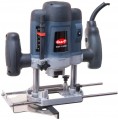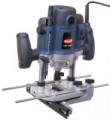Power
The total power of the router, more precisely, the engine installed in it. The
higher this indicator, the more productive the device is, the better it copes with complex work, the more force on the cutter (torque) it provides during operation, and the greater the spindle speed can be (although a powerful tool is not necessarily high-speed). On the other hand, high power significantly affects the dimensions, weight and price of the tool, plus power consumption and network load increase accordingly. In addition, high torque in some cases (for example, with delicate processing) is frankly undesirable. Therefore, a tool should be chosen according to this parameter, taking into account the real needs and the specifics of the planned work.
There are three main categories of milling cutters in terms of power: light (up to 700 W), designed mainly for simple household work; medium (up to 1500 W), able to cope not only with domestic, but also with most professional tasks; and heavy (1500 W or more), used in cases where high power is critical. However, this gradation is true only for routers (see "Type"), other varieties have their own specifics: for example, lamellar models, in principle, do not need high power.
Max. collet diameter
The largest collet size that the router can use.
A collet is a special type of fastening used, in particular, for installing working nozzles in milling cutters. For proper installation, the size of the collet must match the size of the cutter shank. Modern cutter shanks and collets for them have standard sizes - 6, 8 or 12 mm. The larger the size, the larger the cutter itself, the more powerful the tool and the more difficult the work for which it is intended.
As a rule, the maximum size of the collet is the size of the fixture that is standardly installed in the router. Thinner cutters can be mounted using special adapters (however, care must be taken, as such a nozzle may not be designed for the increased power characteristic of tools with a large collet).
6mm collets are found predominantly in light routers (see "Power"),
8mm mounts are found in most intermediate and professional level tools, and
12mm collets are found in the most powerful and heavy models.
Stroke
The distance by which the height of the cutter can change relative to the support platform of the router, in other words, to what depth the working nozzle can be lowered relative to the upper position. This parameter is used for vertical and edge models (see "Type"); however, edge routers with height adjustment are very rare. In fact, the amount of travel not only describes the maximum working depth provided by the tool, but also indicates the presence of depth adjustment; for models without such adjustment, this parameter is not indicated at all.
As for specific numbers, for simple household work, a stroke of 25–30 mm is considered quite sufficient, and in a more serious tool, values of 70–80 mm can be found.

